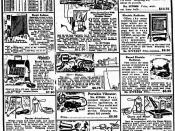Modern advertising really began in the middle of the century. World War II had taught Americans plenty about propaganda and new technologies had erupted, offering both increased production and more ways to propagate a media message. They combined to create the modern ad. In addition to stating the facts somewhere in the fine print, advertisers began to lace their ads with ideas designed to appeal to the senses of the reader, as well as the deeper, more emotional self interests of love, sex, anxiety, fear, alarm, ambition, envy, indulgence and especially vanity. And to discover which appeal would work best, advertisers began to develop more and better research techniques -- and act upon the results. Someday, they'd call it "target marketing," but for now, they were content with being able to select the right message to transmit and then aim it at the right receiver in the market.
What sounds obvious now was in fact not recognized in the 19th century.
Advertising was a print medium at first, and primarily followed the basic rules of decorum and factual reporting of the journalism of the day. Thus, a Sears And Roebuck catalogue from the 19th century offered Underwear For Fat Men with a line drawing a hefty, older fellow with a distended belly trying on a pair of longjohns (Sears & Roebuck, 1879, p. 6). In addition to such straightforward advertising, there were rules which limited the effectiveness of print advertising as a visual medium in many venues. Ads were kept in the back in the early 19th century, and only moved across to the front of magazines and newspapers in the 1890s. Line drawings and other artwork was introduced, but the copy remained relatively staid and straightforward.
Print advertising today is far different. Incredible graphics, manipulative copy and inserts, Aadvertorials@...


